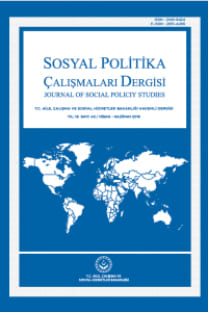Yapısal Aile Danışmanlığı ve Bir Olgu Örneği
İçinde yaşadığımız toplumun, bireysel gereksinimlerin ve beklentilerin gün geçtikçe değişmesi nedeniyle son yıllarda psikolojik danışmanlığa olan ihtiyaç giderek artmıştır. Psikolojik danışma, bireyin yaşantısını gözden geçirmesi ve hayatıyla ilgili kararlarını değerlendirmesi açısından da önemli bir yere sahiptir. Aile danışmanlığı yöntemleri arasında yapısal aile danışmanlığı yöntemi oldukça sık kullanılmaktadır. Bu çalışmanın amacı, yapısal aile danışmanlığı yönteminin incelenmesi ve bir yapısal aile danışmanlığı olgusunun aktarılmasıdır. Çalışmada yapısal aile danışmanlığının tanımı, yaklaşımın kuramsal temelleri, yapısal aile danışmanlığının aşamaları, yapısal aile danışmanlığını organize ederken ve yapılandırırken dikkate alınması gereken faktörler, psikolojik danışmanın rolü, güçlü ve zayıf yönleri açıklanmakta ve bir olgu örneği sunulmaktadır.
Anahtar Kelimeler:
psikolojik danışma, yapısal aile danışmanlığı, olgu örneği
Structural Family Counselling and a Case Example
he society we live in, our individual needs and our expectations change over time, thus, our need of counselling has increased recently comparing to the past. Psychological counselling has an importantpart in terms of individual’s review of their life and assessment of their decisions in their lifetime. Among family counselling methods, structural family counselling methods are used quite oten. In this study, structural family counselling method has been examined and the purpose is to transfer a case report of structural family counselling. Deinition, approaches, phases, necessary factors to organize and structure, the role of consultants, strengths and weaknesses of structural family counselling are explained and a case report is ofered.
Keywords:
counselling, structural family counselling, case example,
___
- Adelman, D., Farwell, L. ve Saathof, A. (22 Eylül 2011). Yapısal aile terapisi-aile sistemi
- terapisi yaklaşımı. (Cinsel Sağlık-Evlilik ve Aile Danışmanlığı Derneği [CİSEAD],
- Çev.) Erişim tarihi: 6 Mart 2014, http://www.cisead.org/videolar/yapisal-aileterapisi-
- aile-sistemi-terapisi-yaklasimi.html.
- Carr, A. (2006). Family therapy. Consept, process and practice (Second Edition). England:
- John Wiley&Sons Ltd.
- Demmitt, A. D. (1998). Using literature to teach the art of diagnosis. he Family of Journal,
- , ss. 147-149.
- Fenell, D. L. ve Weinhold, B. (1989). Counseling families: an introduction to marriage and
- family thearpy. Denver: Love Publishing Co.
- Fishman, H. (1998). Treating troubled adolescents. New York: Basic Books.
- Glading, S. T. (2002). Family therapy history, theory and practice. New Jersey: Merill
- Prentice Hall.
- Goldenberg, L. R. (1992). he development of markers for the big-five factor structure.
- Psychological Assessment, 59, ss. 1216-1229.
- Hines, M. (1988). Similarities and diferences in group work. Journal for Specialist in
- Group Work, 13(4), ss. 173-179.
- Kuzgun, Y. (1991). Rehberlik ve psikolojik danışma. Ankara: ÖSYM Yayınları.
- Liles, R. E. (2007). he use of feature films as teaching tools in social work education.
- Journal of Teaching in Social Work, 27(3/4), ss. 45-60.
- Minuchin, S. (1974). Families and family therapy . USA: Harvard University Press.
- Minuchin, S. ve Colapinto, J. (1998). Working with families of the poor. New York: Guilford.
- Nazlı, S. (2000). Aile danışmanlığı. Ankara: Nobel Yayınları.
- Nichols, M. P. ve Schwartz, R. C., (1997). Family therapy. Boston: Needham Heights MA:
- Allyn and Bacon.
- Nichols, M. P. (2010). Family therapy, concept and methods. Belmont CA: Prentice Hall.
- Özabacı, N. ve Erkan, Z. (2013). Aile danışmanlığı kuram ve uygulamalara genel bir bakış.
- Ankara: Pegem A Yayıncılık.
- Trotzer, J. E. (1988). Family theory as a group resource. Journal for Specialist in Group
- Work, 13(4), ss. 180-185.
- Vetere, A. (2001). Structural family therapy. Child Psychology and Psychiarty Review, 6(3),
- ss. 133-139.
- ISSN: 2148-9424
- Yayın Aralığı: Yılda 4 Sayı
- Başlangıç: 2012
- Yayıncı: Aile,Çalışma ve Sosyal Hizmetler Bakanlığı
Sayıdaki Diğer Makaleler
Uzm. Psk. Dan. Rabia ŞENTÜRK AYDIN, Prof. Dr. Serap NAZLI
Sosyal Politika Çalışmaları Dergisi
Toplumsal Cinsiyet Temelinde Türkiye’de Kadın ve Eğitim
Yrd. Doç. Dr. Kevser ÖZAYDINLIK
Afyonkarahisar İlinde Zorunlu İkamet Eden Sığınmacı Kadınların Sosyal Destek Algılarının İncelenmesi
Yrd. Doç. Dr. Münevver CAN YAŞAR, Yrd. Doç. Dr. Gözde İNAL KIZILTEPE, Arş. Gör. Özgün UYANIK, Öğr. Gör. Suphi ÖZSÜER, Prof. Dr. Adalet KANDIR, Vural ASLAN
Engelliliği Açıklayan Sosyal Model Nedir?
Yapısal Aile Danışmanlığı ve Bir Olgu Örneği
Uzm. Çocuk Gelişimci Alev ÜSTÜNDAĞ
Aile Aidiyeti Ölçeği: Bir Ölçek Geliştirme Çalışması
Prof. Dr. Aliye MAVİLİ, Öğr. Gör. Dr. Nur Feyzal KESEN, Öğr. Gör. Dr. Serap DAŞBAŞ
